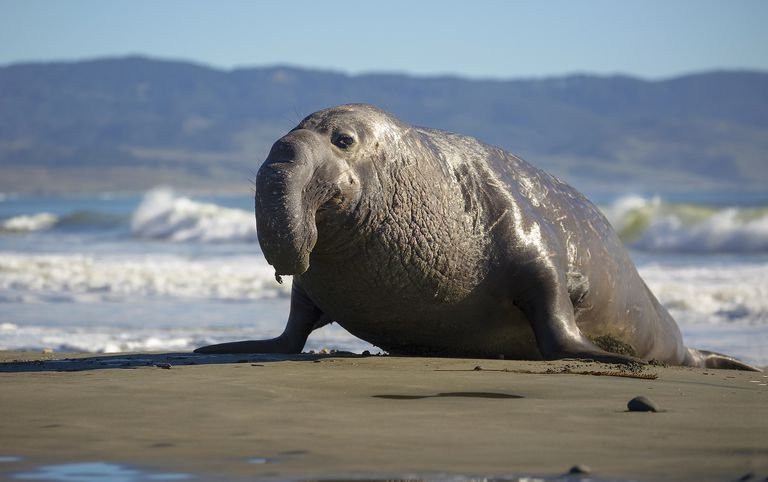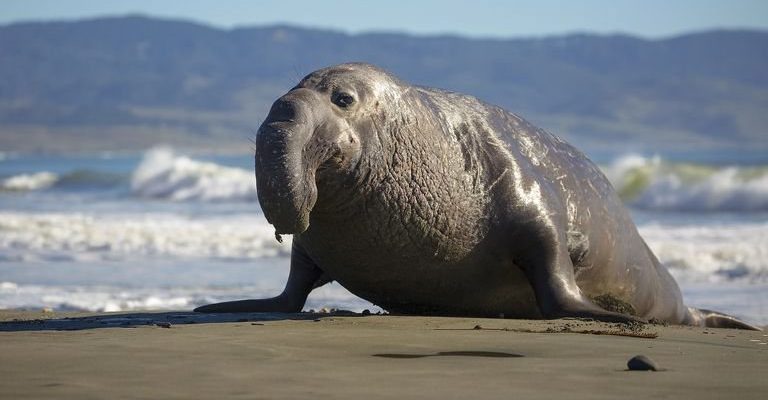
Let’s dive into the world of elephant seals, exploring their status, the threats they face, and the ongoing conservation efforts aimed at ensuring their survival. It’s a bit like tending a garden; sometimes, you need to pull out the weeds and give the plants some extra care to help them flourish. So, grab your coffee, and let’s chat about these remarkable marine mammals!
What Are Elephant Seals?
Elephant seals are large marine mammals belonging to the family Phocidae. There are two main species: the Northern elephant seal and the Southern elephant seal. They’re known for their extraordinary size, with males weighing up to 4,500 pounds and measuring up to 20 feet long! Imagine that—about the length of a small car.
These seals are remarkable for their deep, powerful dives. They can plunge down to depths of over 5,000 feet in search of food, mainly fish and squid. When they’re not swimming, you’ll typically find them lounging on beaches, sunning themselves. Sounds pretty relaxing, right?
Elephant seals have a unique social structure, especially during the breeding season when males engage in fierce battles for dominance. It’s a bit like a heavyweight boxing match, where only the strongest get to mate with females.
Why Were Elephant Seals Endangered?
Historically, elephant seals faced serious threats that brought them to the brink of extinction. In the late 1800s, they were hunted nearly to extinction for their blubber, which was used in oil production. It’s hard to imagine that such majestic creatures were once reduced to mere products on a store shelf.
During that time, the population plummeted to as low as 20 individuals. Can you believe that? Just 20! It’s a stark reminder of how human activities can profoundly impact wildlife. Thankfully, in the 20th century, protections were put in place, and hunting was banned. These legal restrictions were a critical turning point in their journey toward recovery.
Despite this, the journey hasn’t been entirely smooth. Even today, elephant seals face challenges, including habitat loss and increased human interaction, which can lead to stress and behavioral changes. It’s a constant balancing act between conservation and the ever-growing human footprint.
Current Conservation Status
As of now, elephant seals are classified as *least concern* on the IUCN Red List. This means that, while they are no longer on the brink of extinction, their future still hangs in the balance. Their population has rebounded, with estimates for Northern elephant seals at around 200,000 individuals and Southern elephant seals at about 600,000.
However, it’s important to note that their recovery wasn’t without challenges. The numbers might look promising, but fluctuations in food availability and climate change remain significant threats. You might be wondering, “What can we do to help?” Let’s explore some conservation efforts in place.
Conservation Efforts and Successes
The comeback of elephant seals is a triumph of conservation efforts, but there’s still work to be done. Numerous organizations and governmental agencies are actively engaged in studying and protecting these fascinating animals. Here are a few key initiatives:
- Breeding Monitoring: Many beaches, particularly in California, are designated as protected areas where elephant seals breed. Researchers closely monitor these sites to ensure a safe environment for mothers and pups.
- Public Education: Education programs inform the public about the importance of elephant seals and the challenges they face. This awareness helps to build community support for conservation efforts.
- Rescue and Rehabilitation: In cases where seals are found injured or malnourished, there are rescue teams ready to help. Rehabilitation programs work to nurse them back to health before releasing them back into the wild.
These efforts exemplify how teamwork among scientists, conservationists, and the public can make a real difference. It’s a bit like a community coming together to support a neighbor in need.
Threats Still Facing Elephant Seals
While conservation efforts have led to a remarkable recovery, elephant seals still face various threats that can impact their population. Here are some of the biggest challenges they encounter:
- Climate Change: Rising ocean temperatures can affect the availability of food sources like fish and squid. As the seals depend on these creatures for sustenance, changes in their diets could lead to nutritional stress.
- Human Interaction: Increased tourism in coastal areas can disturb their breeding and resting sites. People getting too close can cause seals to flee, leaving their pups vulnerable.
- Marine Pollution: Pollution in the ocean can have dire consequences for elephant seals. Toxins in the water can affect their health, and entanglement in debris can lead to injury or death.
Understanding these threats is crucial for formulating effective conservation strategies. It’s not just about protecting seals; it’s about preserving the entire marine ecosystem.
How You Can Help Elephant Seals
You might be thinking of ways to make a difference for elephant seals, and there are plenty of options! Here are some simple yet impactful actions you can take:
- Support Conservation Organizations: Donating to groups focused on marine mammal conservation helps fund research and protection efforts.
- Practice Responsible Tourism: If you visit coastal areas where seals are present, keep a respectful distance and follow local guidelines to minimize disturbances.
- Reduce Plastic Use: Cutting down on single-use plastics can help decrease marine pollution and make our oceans a safer place for wildlife.
Even small actions can lead to significant changes. It’s like planting a seed and watching it grow into a beautiful tree over time.
Future of Elephant Seals
The future for elephant seals seems cautiously optimistic. Thanks to rigorous conservation efforts and public interest in protecting these unique animals, their populations are on the mend. However, it’s important to remain vigilant. Climate change and human activities will continue to pose challenges.
Everyone has a role to play in protecting our oceans and the creatures that inhabit them. By staying informed and proactive, we can ensure that elephant seals continue to thrive for generations to come.
Let’s make sure that the story of elephant seals isn’t just a tale of recovery, but one of enduring strength and resilience. After all, they have bounced back from the brink, and it’s our job to help them stay strong.

